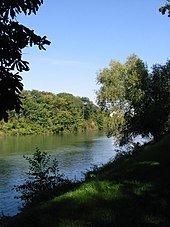Native name La Marne Main source Champagne-Ardenne Discharge 100 m³/s | River mouth Seine Length 514 km Source Champagne-Ardenne | |
 | ||
Basin size 12,800 km (4,900 sq mi) Similar | ||
The Marne is a river in France, an eastern tributary of the Seine in the area east and southeast of Paris. It is 514 kilometres (319 mi) long. The river gave its name to the départements of Haute-Marne, Marne, Seine-et-Marne, and Val-de-Marne.
Contents
Map of Marne, France
The Marne starts in the Langres plateau, runs generally north then bends west between Saint-Dizier and Châlons-en-Champagne, joining the Seine at Charenton just upstream from Paris. Its main tributaries are the Rognon, the Blaise, the Saulx, the Ourcq, the Petit Morin and the Grand Morin.
In the Champagne région, part of the water is led through the artificial lake Lac du Der-Chantecoq, in order to regulate the water discharge. This way, large inundations or low river levels downstream are prevented.
The Celts of Gaul worshipped a goddess known as Dea Matrona ("divine mother goddess") who was associated with the Marne.
The Marne is famous as the site of the eponymous two battles during the First World War. The first battle was a turning point of World War I, fought in 1914. The second battle was fought four years later, in 1918.
During the 19th and 20th centuries the Marne inspired many painters, among whom were:
Navigation
During the heyday of canal transportation, the Marne was a major artery connecting Paris and the Seine with major rivers nearby such as the Meuse (via the Canal de l'Aisne à la Marne and the Canal des Ardennes), the Moselle and the Rhine (via the Marne–Rhine Canal), and the Saône and Rhône (via the Canal de la Marne à la Saône). To facilitate transportation along the Marne itself, a number of lateral canals were constructed alongside. The most extensive was the Canal latéral à la Marne, which runs 67 km (42 mi) between Vitry-le-François and Dizy. Downstream of this were several more, including the Canal de Meaux à Chalifert, the Canal de Chelles, and the now-lost Canal de Saint-Maurice which ended in Charenton-le-Pont near the Marne's confluence with the Seine. Furthermore, a portion of the Canal de l'Ourcq also runs parallel and quite close to the Marne before swinging away to enter Paris from the north; at one time the two were linked by a canal inclined plane near Meaux.
